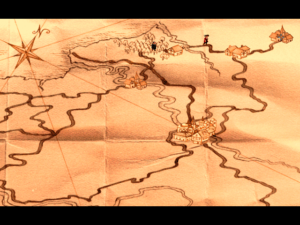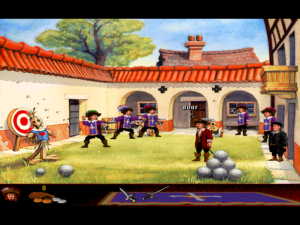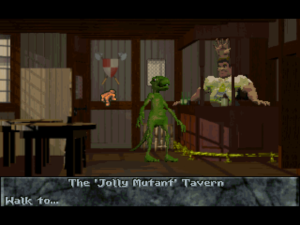So, is Kingdom O’ Magic a good game? No, not really. It’s more playable than certain other point-and-click adventures I’ve played lately, and the wandering monsters were a good attempt at keeping the walking-around bits interesting, but I actually think the multi-path nature of the thing backfired somewhat. See, not only are there three quests, there are a number of optional puzzles and alternate solutions to puzzles. For example, there’s a whole complicated chain of actions that culminates in obtaining a palantir. This was one of the last things I did in the game, and by the time I had done it, I had already solved the puzzle that uses the palantir by other means, effectively short-circuiting a large portion of the game and leaving me wondering what the palantir was for and why I had devoted all this effort to obtaining it. My expectation was that any puzzle I left unsolved in the first two quests would become important in the third, but that’s just not the case.
(One strange thing: I distinctly remember certain aspects of the palantir from my earlier attempts at the game, like that it’s dangerous to hold directly, because the Dark Lord can sense that you have it, so you have to carry it around in a box. So I feel like I must have gotten it before, but there were steps along the way that I didn’t recognize at all. Maybe I got further into this game than I know.)
The humor varies — it manages some really good gags, but it’s basically an r-strategy comedy, going for quantity of jokes over quality in the hope of overwhelming the audience with the cumulative effect, like an old Leslie Nielsen film. And it skews low-brow. Full of silly voices, cartoon sound effects, and occasional full-screen stock black-and-white film footage. I haven’t emphasized this enough before: toilets are a major recurring theme. There are at least four of significance, including one that’s just sitting out in the open next to the road. Can you flush them? No, but you can plunge them, using a plunger that, like the palantir, is somewhat complicated to obtain and only used in a completely optional puzzle. My last goal of any difficulty in the game was to obtain a lost grail so I could trade it for some toilet paper.
Then there’s the stereotype humor. There’s a gay-coded hairdresser, pink of shirt and limp of wrist. They don’t even really make jokes about this; you’re basically just supposed to be amused at how stereotypically gay he is. Next door, there’s a wig maker, who is, quite at random, a comical Nazi — that is, he’s not explicitly a Nazi, there’s no swastikas or anything around, but he’s got the whole Hogan’s Heroes schtick. Again, the game is just throwing out any and all potentially comic situations the authors could think of, but stuff like this can actually suck humor out of its surroundings. At one point, the player character actually tells a lawyer joke that I remember from the bit in Escape from Monkey Island that makes fun of lawyer jokes.
I’ll give it this: Coming straight off a game that really wanted to imitate Monkey Island‘s sense of humor, it was quite refreshing to see that this game’s sense of humor was completely different.
And it’s kind of mean-spirited, too. It would come off as more so if it weren’t so wacky; there’s a whole lot of killing of things you can have conversations with, sometimes electively. There’s a sort of new-age hippie peacenik character who seems to be included in the game specifically so you can kill her if you’re so inclined. (Meanwhile, the comical Nazi is not killable.) The first thing that made me really think “Wow, okay, this is kind of mean” is the gnome-stomping. There’s a trio of gnomes in one of the quests, and you’re expected to jump on them, squashing them into pointy-hatted pancakes. They re-inflate after a little while (to provide a bit of challenge in getting all three down at the same time), but it’s a grotesque moment, and you just have to decide whether you like the game being mean and grotesque or not. I don’t particularly.
I can imagine a lot of this bothering me less in a text adventure, where it’s all a little more abstract. As it is, I really cannot recommend this game. I stand by what I said before about the game being campy and reveling in its own deliberate badness, but on the whole, I think it’s better to be playing a game that isn’t bad.
Not that I’m going to take my own advice. I’ve got some momentum going here, and I’m not going to stop while I still have some crappy MS-DOS point-and-click adventure games on the Stack.
 Comments(0)
Comments(0)

